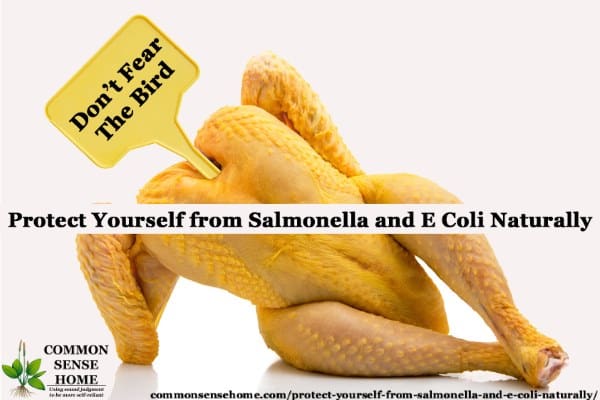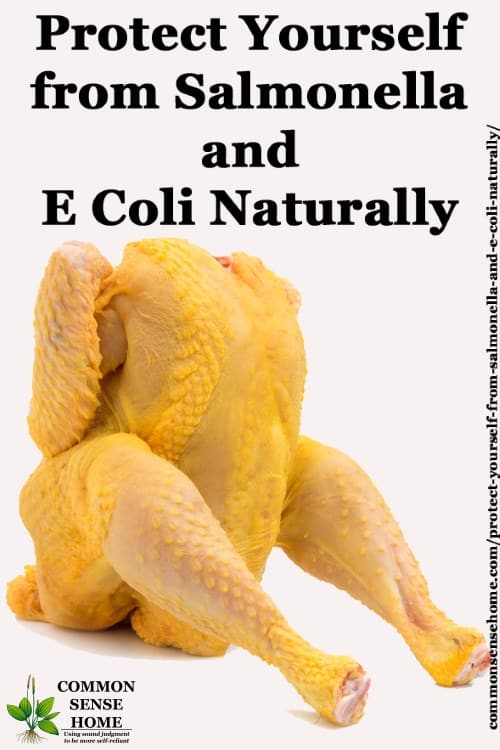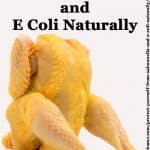Protect Yourself from Salmonella and E Coli Naturally
This post may contain affiliate links. Read my full disclosure here.
It seems like every time you turn on the news there’s another food recall. If you check the FDA food recall list, there are literally dozens of products listed at any given time. Big gatherings where food sits out for hours – for instance, potlucks – often end up with people ill from some degree of food poisoning. There are ways you can help protect yourself from salmonella and e coli naturally.

Note: This article contains advice on general food safety and boosting your immune system. It is for general information purposes only.
If you are experiencing severe pain, vomiting, diarrhea or other complications, please consult your healthcare practitioner immediately! I am not a doctor, I am only sharing what works for me and my family.
Know Your Pathogens
E coli (Escherichia coli) and Salmonella bacteria are commonly found in the digestive systems of humans and animals.
The CDC states that:
“Most E. coli are harmless and actually are an important part of a healthy human intestinal tract. However, some E. coli are pathogenic, meaning they can cause illness, either diarrhea or illness outside of the intestinal tract.”
The term “Salmonella” is used to cover roughly 2,000 similar types of bacteria, which vary in degrees of potential illness.
How do with get infected with the types of e coli or salmonella that make us sick? From the CDC:
“The types of E. coli that can cause diarrhea can be transmitted through contaminated water or food, or through contact with animals or persons.”
Salmonella behaves in a similar manner – which is why we see illness outbreaks connected to food recalls.
According to WebMD, reptiles, baby chicks and ducklings, and small rodents are particularly likely to carry salmonella. Thorough hand washing should always follow handling these types of animals.
So why do some people get sick when exposed harmful bacteria, while other do not?
If you are exposed to a very large amount of a pathogen, your risks increase dramatically. Some strains of bacteria are also more virulent than others.
People with depressed or immature immune systems are also at greater risk, such as the very young, the very old, and those already dealing with illness or treatments that involve weakening the immune system, such as chemotherapy.
“It is not the germ that causes disease but the terrain in which the germ is found.”
The Biological Terrain Theory versus the Germ Theory of disease is more fully explained at Timeless Remedies, but basically it amounts to a belief that a susceptible body falls ills while a healthy body can resist illness, even when exposed to pathogens.
I have seen the effectiveness of this theory demonstrated within my own family.
We don’t get sick very often, and when we do, it’s generally fairly minor. We still always follow food safety rules! (See below.)
A digestive system filled with healthy bacteria is less hospitable to harmful bacteria. The article “What Are Probiotics” states:
- Probiotics reduce the levels of harmful bacteria such as E.Coli and Salmonella by producing metabolic end-products that inhibit or antagonize them. These compounds include hydrogen peroxide, lactic and acetic acids. **
- Inhibiting levels of microbial pathogens: L. Acidophilus may inhibit pathogens by lowering the pH in the intestines. The production of organic acids effectively lowers intestinal pH to a level that is beneficial to good bacteria and destructive to pathogens.
- Protecting the immune system. Some research ( see link at right) shows that L. Bulgaricus and L. Casei are the truly effective strains for this function.
- Preventing establishment of harmful fungus and parasites: L. Acidophilus and B. Bifidus aggressively attach themselves to the walls of the colon. In doing so, they may inhibit Candida albicans, bacteria and the parasite Giardia lamblia.
- Lowering levels of toxic by-products: Harmful bacteria can produce toxins, such as indole, skatole, and methane because of their metabolic reaction to certain foods. Reducing their numbers may lower toxin levels in the colon.
The meat industry is starting to take note of this, and introducing probiotics to chickens and pigs to reduce the incidence of salmonella.
Introduce Probiotics Before You Become Ill
While I always consume probiotics during illness, maximum resistance to food-borne illness results from continually consuming live culture foods.
Indeed, some studies have shown that introducing certain probiotics after salmonella has already infected the body does not improve healing.
Would you like to save this?
For recipes for probiotic foods, visit the “Live Culture Foods/Probiotics/Ferments” section of the Recipes page, and more about the role of probiotics in fighting illness in the post, “Preparing for Cold and Flu Season – Step #1- Probiotics“.
What Do I Do If I’m Already Sick?
***If you are experiencing severe pain, vomiting, diarrhea or other complications, please consult your healthcare practitioner immediately! I am not a doctor, I am only sharing what works for me and my family.***
If you have stomach flu type symptoms and are not sure if your illness is viral or bacterial in nature, you may want to consult this article on the “stomach flu”. (“Stomach flu” is not caused by the influenza virus, but other virus families.)
If you know that you are facing a bacterial illness, the book Herbal Antibiotics recommends the following:
Herbs for E. Coli treatment – Goldenseal, garlic, eucalyptus, cryptolepsis, juniper, acacia, sage, ginger, grapefuit seed extract
Herbs for Salmonella treatment – Garlic, eucalyptus, wormwood, juniper, goldenseal, sage, ginger, acacia, grapefruit seed extract, Terminalia spp., Punica spp.
Learn more about Herbal Antibiotics.
General Guidelines for Avoiding Salmonella and E Coli Poisoning
Salmonella.org gives the following USDA recommendations for avoiding salmonella, which are also good recommendations for avoiding any type of food poisoning:
- Wash Hands and Surfaces Often
- Wash your hands, cutting boards, dishes etc with hot soapy water before handling food.
- Separate raw meat, poultry, and seafood from other foods in your refrigerator.
- Cook to Proper Temperatures, at least 160°F (72°C) internal temp
- Refrigerate Promptly
For instance, you can fill this Inflatable Salad Bar with ice to keep food cool.
I prefer wood cutting boards over plastic, as they are naturally antibacterial.
You can read more about the antibacterial properties of wooden cutting boards, as well as care instructions and additional kitchen food safety tips in the post, “Why Wooden Cutting Boards are Best“.
Romaine Lettuce Recalls
Do not eat raw greens contaminated with salmonella or e coli.
The source of the bacteria is the water that they use to water the plants, and CANNOT BE WASHED OFF, since it is inside the plant. Return or dispose of the greens, and clean areas (like the crisper drawer in the refrigerator) that they touched.
NOTE: Do not compost the romaine lettuce contaminated with E. coli. (O157:H7), unless you have a very hot compost pile.
In a Facebook post dated 11/21/18, the Centre County Recycling & Refuse Authority of Bellefonte, Pennsylvania, states:
It takes temperatures of 160 degrees Fahrenheit over 10 days to kill the particular strain of E. coli. (O157:H7) in the current romaine lettuce contamination.
While the composting process occasionally reaches, and sometimes exceeds, temperatures of 155 degrees Fahrenheit in the Borough’s open windrow composting method, there is no guarantee the processing will hit 160 degrees Fahrenheit for a full 10 days, especially in the winter.
This correlates to the results of a recent study that indicate some E coli may have increased heat resistance.
The article “Ground beef may need higher cooking temperature to be safe” notes that a suite of genes has been discovered that gives some E coli bacteria increased heat resistance. They refer to this as the locus of heat resistance, or LHR.
Approximately 2% of both pathogenic and non-pathogenic E coli carry this genetic trait. They are still working to determine updated cooking guidelines.

For safe home canning tips, please visit:
If you found this post useful, please considering sharing it.
Originally posted in 2011, updated in 2018.


Hi Laurie,
I really enjoy your posts, but I simply couldn’t read this particular one and NOT post.
You stated above that “E coli 157:H7 bacteria is perfectly healthy and safe, as are many other strains.” – this is possibly the most deadly strain of this bacteria.
I am a qualified, professional, food safety manager based in Ireland. I can tell you that E.Coli poisoning causes extreme illness and in a lot of cases death through hemorrhagic diarrhoea and kidney failure. I think that you need to do some serious research on topic like this, before you start giving medical advise to people.
I also think you need to state that you are not a doctor at the beginning of this article.
Raw manuka honey will not stop an already present salmonella or e.coli poisoning. This requires serious and quick medical treatment.
The reason that some people will get sick and others won’t is because of two variables:
1. the amount of the bacteria that you ingest
2. whether you are “high risk” or not. High risk people are very young, very old, already ill or with weakened defence systems (such as disability or chemotherapy)
E.coli is found in dirty water, raw milk and undercooked meats. It can also be found on unwashed vegetables where the soil was contaminated.
For actual factual information, you should check out http://www.who.int/mediacentre/factsheets/fs125/en/
Please be more careful with what you are recommending!
Also, wood is not naturally antibacterial, and will actually promote the growth of pathogens on your chopping board.
Thank you for correcting me on the e coli strain. I have made the correction in the post and added additional information to clarify.
I did state that I am not a doctor in the post and encouraged people to seek treatment if needed, specifically:
“***If you are experiencing severe pain or other complications, please consult your healthcare practitioner immediately! I am not a doctor, I am only sharing what works for me and my family.***”
To make this even more obvious, I added it again at the beginning of the post.
There is at least some research suggesting that raw manuka honey is effective against e coli, specifically: “Comparison of the Antibacterial Efficacy of Manuka Honey Against E.faecalis and E.coli – An In vitro Study“. Still, rather than risking someone ignoring the advice to seek medical help in case of serious illness and self medicating with honey, I removed this section of the post.
I added information on those who are most at risk, and the risk associated with ingestion and/or contact with large amounts of pathogen. I also added information about animals that are most likely to transmit the pathogens, since kids like to handle critters and then put their hands near their mouths.
Finally, wood is naturally antibacterial, as demonstrated by the scientific studies referenced in the linked post. Quoting from that article and the linked study results:
“The scientists found that three minutes after contaminating a board that 99.9 percent of the bacteria on wooden boards had died, while none of the bacteria died on plastic. Bacterial numbers actually increased on plastic cutting boards held overnight at room temperature, but the scientists could not recover any bacteria from wooden boards treated the same way.”
“(This study) revealed that those using wooden cutting boards in their home kitchens were less than half as likely as average to contract salmonellosis (odds ratio 0.42, 95% confidence interval 0.22-0.81), those using synthetic (plastic or glass) cutting boards were about twice as likely as average to contract salmonellosis (O.R. 1.99, C.I. 1.03-3.85); and the effect of cleaning the board regularly after preparing meat on it was not statistically significant (O.R. 1.20, C.I. 0.54-2.68).”
Shona, I have always wondered if mayonnaise is made the traditional way with ‘raw’ egg. Is there a way to make this food safe? I have wondered if fermenting the homemade mayo or the egg would create an environment that would kill off any potential pathogens such as salmonella. What are your thoughts as an expert?
There is a super easy way to protect yourself: don’t eat dead animals! It’s so much better for your health, the planet and the animals. Eating plantbased (rice, beans, fruits, veggies, grains etc.) alters your gut bacteria which protects you against many diseases, including cancer. It also protects against heart disease and diabetes. It’s a win-win-win really
Eating salad didn’t exactly work out so well for the folks killed and sickened by Dole Foods salad listeria contamination – Dole Salad Recalled After Listeria Kills 1, Sickens 12
Or the folks sickened by e coli in lettuce – E. coli-Contaminated Lettuce Came from a California LGMA Grower
But if you feel veganism is right for you, but all means, follow your passion.
I’m afraid dr making my mother in law sicker with antibodies she has E. coli everytime the dr changes her Meds See gets worse she is weak tired like she would have flu help anyone she’s old and hard headed any ideas to try naturally
Have you spoken to your doctor about your concerns? That would be my first suggested course of action (even though they may not listen).
Most practitioners now advise patients who take antibiotics to also include probiotics, spaced at least 4 hours apart from the antibiotic dose. You can also include live culture foods in her diet, like yogurt, kefir and raw kraut. I use 10 Strain Probium probiotics, because they have strains that are shelf stable and can get into the intestines. (Yogurt cultures, for instance, don’t stay active very far into the guts.)
If you go probiotic shopping, look for some of these strains of microbes on the label: Lactobacillus acidophilus, Lactobacillus casei, Lactobacillus paracasei, Lactobacillus plantarum, Lactobacillus rhamnosus, Lactococcus lactis, Bifidobacterium bifidum, Bifidobacterium breve, Bifidobacterium lactis and Bifidobacterium longum
plants have just as many issues as meats do,remember the romaine lettuce issue, I was a victom of that, and they are always doing recalls on all kinds of foods,probly because a lot of it is grown with sewer sluge,even though they put a USDA stamp on it,mexicos practices they consider human waste to be organic,I alway cook the crap out of everything,mainly pressure cook that will kill anything,can not trust of food sources anymore,I am still fighting for my life 8 plus yrs ,assulted many times over with one thing or the other
There is a Chinese herbal formula that works great for food poisoning and stomach flus. It’s called Huo Xiang Zheng Qi Tang/Shui, and you can get it in Chinatown. I’ve also seen it in some health food stores. Take at the earliest onset every two hours until symptoms subside…works like a charm.
Activated charcoal is also good for food poisoning.
Sharing on my FB page now. Thanks.
Thanks, Adrienne.
Wash your hands as much as possible when handling food especially if you are the one handling the food.
Humble homemaker – you're welcome and good luck! Probiotics have many health benefits.
Great post! Maybe I can get my hubby to remember to take his probiotics if he reads this! Thank you for sharing!
Great post! I love your common-sense and well-researched approach. We also use garlic and ginger (as in very flavorful ginger beef, or even just plain garlic) when friends have tummy upsets, and we rarely get them; that's not the same thing as bacterial infections, of course, but it's another thing to think about.
Annie Kate
Thank you, Heidi.
Fermented foods can be hard for people to get used to, especially since many of us have palates trained to sweeter foods. I keep experimenting with my family. Some things go over better than others, and friends and neighbors help me eat the rest! I wouldn't be without live culture foods as a part of my diet now that I've experienced their benefits.
Laurie-
You are always a wealth of great information. I appreciate this post. I have been trying to convince my family to eat lactic fermented foods for a while now, and I think this post makes a pretty good argument. The boys are bound to see the benefits after they read this. Thanks so much!
You're welcome.
Great information. Thank you so much!
Thanks, Raine.
Fantastic post Laurie! Thanks for shedding some common sense that isn't so common in the backward world of modern medical "miracles". 🙂